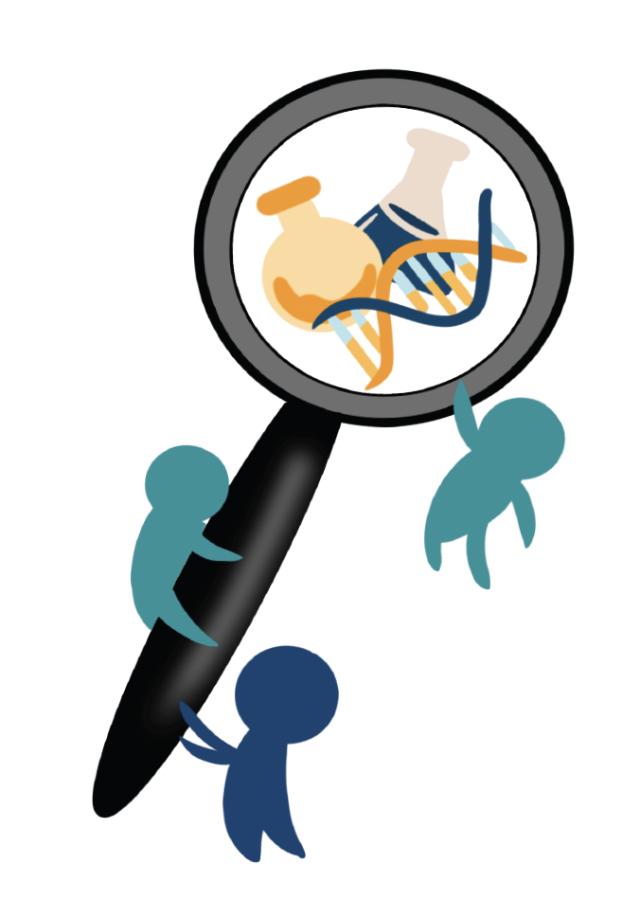Researching the passage of Research Club
Graphic illustration by Amy Liu and Samyukta Sarma
At Lynbrook, the home of more than 80 clubs and even more rejected ones, Research Club’s fast-tracked creation was unique.
October 6, 2021
At Lynbrook, the home of more than 80 clubs and even more rejected ones, Research Club’s fast-tracked creation was unique. The club approval process can be notoriously draining, and typically involves a rigorous sixstep process, beginning with the search for an adviser, and ending with a presentation to Legislative Council, a jury of 27 students.
In recent years, students have referred to Lester Leung, former adviser for Science Club, Lynbrook’s STEM coordinator and Chemistry team lead, for information on research fairs and science competitions. And while the Lynbrook and FUHSD STEM programs may appear to be healthy and thriving, a lack of proper resources have affected the efficacy of work. The responsibility of managing student communication with research organizations falls on the shoulders of one teacher who accepts the paid position. Especially during the fall of a new semester, the STEM Coordinator has a surplus of work, dealing with both back-to-school difficulties and initial submissions to research competitions.
“The amount of interest in STEM from our school is quite high, so there is no way that one person can manage all of that on top of their other duties,” ASB leadership adviser and science teacher Jason Lee said. “We found a deep need for support.”
The Lynbrook STEM program is expansive, encompassing competitions like Science Olympiad and Science Bowl to research showcases like Regeneron and Synopsys. Student engagement in these programs necessitates a lot of paperwork, communication and logistics.
Research Club began in August 2021 as a support system for Leung and Lynbrook’s STEM program. This year, Research Club will essentially act as a mouthpiece for the STEM Coordinator, helping to disseminate important information on dates and guidelines for students interested in STEM research. Their recent meetings have agendas that include discussing research topics, encouraging members to work on proposals and informing participants about summer research opportunities. But most importantly, this club hopes to foster a community on campus of both experienced and inexperienced science-lovers.
“We’re creating a place where students can explore their interests in various topics of research, gain inspiration for personal projects, share ideas, work with other students from interdisciplinary backgrounds and receive peer to peer feedback on research ventures,” said junior Anushree Atmakuri, Research Club’s Vice President of Content.
Preceded by a previous organization at Lynbrook called STEMinars, Research Club was a convenient proposal to a desperate staff. STEMinars was an unofficial Lynbrook club that worked closely with the STEM Coordinator and served a similar purpose to Research Club. It relieved a lot of the responsibility that Leung now handles by increasing student interaction with the STEM process, and after it dissolved over the years, the need for a similar club became evident. By January 2021, Lee and former Assistant Principal Jeff Rosado decided to take the initiative to design a program where students could pitch in to keep STEM running at Lynbrook. In March 2021, a team of five juniors approached Lee with a timely club proposal. Lee and Rosado recognized the club as a necessity to Lynbrook, then approached Leung as a possible adviser. Once Leung accepted the position, the club officers went directly to Principal Maria Jackson, who approved the idea.
In contrast to the customary formation of a club, the creation of Research Club only required the approval of a few administrators, and the final process lasted from March 2021 through June 2021. Typically, a club proposal must go steadily through levels of command: the teacher adviser, Assistant Principal of Activities, ASB Community Link, ASB Vice Presidents and finally, a two-thirds vote by the Legislative Council. This roughly adds up to the necessary approval of 20 to 30 people from different levels of campus leadership. The final judgement of a club often relies upon an evaluation they get from Legislative Council, which is based on a rubric that all council members receive.
“A club is usually judged on their long-term vision, and whether it can be successful in later years,” said junior Anishka Banerjee, member of Legislative Council. “It also depends on how unique the club is compared to the numerous other ones we already have.”
Time was of utmost importance to the approval of Research Club, as submissions for science fairs such as Synopsys close in October. To minimize the workload of STEM faculty, administration chose to bypass the club approval process for Research Club. Research Club is still required to pitch their ideas and introduce themselves to the Legislative Council to determine their future on campus.


































































